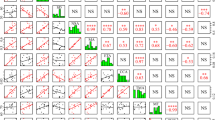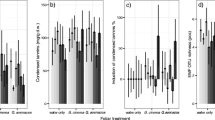Abstract
Arceuthobium sichuanense is an aerial parasitic plant (dwarf mistletoe) which causes severe damage to spruce forests on the Qinghai-Tibet Plateau. Picea crassifolia and Picea purpurea, two main host species of A. sichuanense, have different growth characteristics and elevational distributions. The effects of A. sichuanense infection on P. crassifolia and P. purpurea trees were evaluated by examining needle and current-year shoot morphology, needle water use efficiency and needle nitrogen concentration, with 30 needle samples, 30 current-year shoot samples and 10 A. sichuanense aerial shoot samples for each host species. The most apparent effects were significant reductions in both needle size and current-year shoot length. The high degree of correlation in foliar δ 15N values between the dwarf mistletoe and its host trees indicated that nitrogen in the dwarf mistletoe was derived entirely from its host. Percent reductions in needle and current-year shoot length were smaller for P. purpurea than for P. crassifolia, possibly suggesting that P. purpurea exhibits a lesser capacity to accommodate the parasitic effects of mistletoe infection by adjusting the growth of needles and current-year shoots. The reductions in needle nitrogen concentration and δ 13C values were lower in P. purpurea than in P. crassifolia, indicating that P. purpurea suffered more nitrogen and water stresses and exhibited lower vigor compared to P. crassifolia. Our results demonstrated that P. purpurea may suffer more negative effects induced by dwarf mistletoe infections at needle and branch levels than P. crassifolia.



Similar content being viewed by others
References
Baker, F. A., O’Brien, J. G., Mathiasen, R., & Ostry, M. E. (2006). Eastern spruce dwarf mistletoe. Forest insect and disease leaflet NA-PR-04-06. Newtown Square: USDA Forest Service.
Bannister, P., & Strong, G. L. (2001). Carbon and nitrogen isotope ratios, nitrogen content and heterotrophy in New Zealand mistletoes. Oecologia, 126, 10–20.
Cechin, I., & Press, M. C. (1993). Nitrogen relations of the sorghum-Striga hermonthica host-parasite association: growth and photosynthesis. Plant Cell and Environment, 16, 237–247.
Chapin III, F. S., & Van Cleve, K. (1990). Approaches to studying nutrient uptake, uses, and loss in plants. In P. W. Pearcy, J. R. Ehleringer, H. A. Mooney, & P. W. Rundel (Eds.), Plant Physiological Ecology: Field Methods and Instrumentation (pp. 185–207). London, UK: Chapman and Hall.
Chen, S. P., Bai, Y. F., Zhang, L. X., & Han, X. G. (2005). Comparing physiological responses of two dominant grass species to nitrogen addition in Xilin River basin of China. Environmental and Experimental Botany, 53, 65–75.
Dobbertin, M., & Rigling, A. (2006). Pine mistletoe (Viscum album ssp. austriacum) contributes to scots pine (Pinus sylvestris) mortality in the Rhone valley of Switzerland. Forest Pathology, 36, 309–322.
Ehleringer, J. R., Schulze, E. D., Ziegler, H., Lange, O. L., Farquhar, G. D., & Cowan, I. R. (1985). Xylem-tapping mistletoes: water or nutrient parasites? Science, 227, 1479–1481.
Geils, B. W., Tovar, J. C., & Moody, B. H. (2002). Mistletoes of North America (p. 123). Ogden: USDA Forest Service, Rocky Mountain Research Station.
Hawksworth, F. G. (1977). The 6-class dwarf mistletoe rating system. General Technical Report RM-48. Fort Collins: USDA Forest Service, Rocky Mountain Forest and Range Experiment Station (p. 7).
Hawksworth, F. G., Wiens D. (1996). Dwarf mistletoes: biology, pathology, and systematics. Agricultural Handbook 709. Washington DC: USDA Forest Service.
Hull, R. J., & Leonard, O. A. (1964). Physiological aspects of parasitism in mistletoes (Arceuthobium and Phoradendron). I. The carbohydrate nutrition of mistletoe. Plant Physiology, 39, 996–1007.
Knutson, D. M. (1983). Physiology of mistletoe parasitism and disease response in the host. In M. Calder & P. Bernhardt (Eds.), The Biology of Mistletoes (pp. 295–316). Sydney: Academic Press.
Kolb, T. E. (2002). Ecophysiology of parasitism in the Plant Kingdom. In J. A. Lopez Saez, P. C. Rodriguez, & L. Saez (Eds.), Plantas Parasitas del la Península Ibéríca e Islas Baleares (pp. 57–85). Madrid: MundiPresna.
Küppers, M. (1992). Carbon discrimination, water-use efficiency, nitrogen and phosphorus nutrition of the host / mistletoe pair Eucalyptus behriana F. Muell and Amyema miquellii (Lehm.Ex Miq.) Tiegh. At permanently low plant water status in the field. Trees, 7(1), 8–11.
Li, M. C., Liu, H. Y., Song, D. W., & Li, L. X. (2007). Water use efficiency and nitrogen use efficiency of alpine plants grown in the east of Qinghai-Tibet Plateau. Acta Botanica Boreali-Occidentalia Sinica, 27(6), 1216–1224.
Liu, X. H., Zhao, L. J., Gasaw, M., Gao, D. Y., Qin, D. H., & Ren, J. W. (2007). Foliar δ 13C and δ 15N values of C3 plants in the Ethiopia Rift Valley and their environmental controls. Chinese Science Bulletin, 52(9), 1265–1273.
Livingston, N. J., Guy, R. D., Sun, Z. J., & Ethier, G. J. (1999). The effects of nitrogen stress on the stable carbon isotope composition, productivity and water use efficiency of white spruce (Picea glauca (Moench) Voss) seedlings. Plant Cell and Environment, 22(3), 281–289.
Logan, B. A., Huhn, E. R., & Tissue, D. T. (2002). Photosynthetic characteristics of eastern dwarf mistletoe (Arceuthobium pusillum peck) and its effects on the needles of host white spruce (Picea glauca (Moench) Voss. Plant Biology, 4, 740–745.
Logan, B. A., Reblin, J. S., Zonana, D. M., Dunlavey, R. F., Hricko, C. R., Hall, A. W., et al. (2013). Impact of eastern dwarf mistletoe (Arceuthobium pusillum) on host white spruce (Picea glauca) development, growth, and performance across multiple scales. Physiologia Plantarum, 147, 502–513.
Ma, J. H., Huai, W. X., & Zhao, F. Y. (2007). Arceuthobium sichuanense, a parasitic plant attacking spruce in Qinghai Province. Forest Pest and Disease, 26(1), 19–21.
Meinzer, F. C., Woodruff, D. R., & Shaw, D. C. (2004). Integrated responses of hydraulic architecture, water and carbon relations of western hemlock to dwarf mistletoe infection. Plant Cell and Environment, 27, 937–946.
Panvini, A. D., & Eickmeier, W. G. (1993). Nutrient and water relations of the mistletoe Phoradendron leucarpum (Viscaceae): how tightly are they integrated? American Journal of Botany, 80, 872–878.
Pate, J. S. (1995). Mineral relationships of parasites and their hosts. In M. C. Picss and J. D. Graves (Ed.), Parasitic Flowering Plants (pp. 80–99). London: Chapman and Hall.
Pate, J. S., True, K. C., & Rasins, E. (1991). Xylem transport and storage of amino acids by S. W. Australian mistletoes and their hosts. Journal of Experimental Botany, 42, 441–451.
Patterson, T. B., Guy, R. D., & Dang, Q. L. (1997). Whole-plant nitrogen- and water-relations traits, and their associated trade-offs, in adjacent muskeg and upland boreal spruce species. Oecologia, 110, 160–168.
Reblin, J. S., & Logan, B. A. (2015). Impacts of eastern dwarf mistletoe on the stem hydraulics of red spruce and white spruce, two host species with different drought tolerances and responses to infection. Trees, 29, 475–486.
Reblin, J. S., Logan, B. A., & Tissue, D. T. (2006). Impact of eastern dwarf mistletoe (Arceuthobium pusillum) infection on the needles of red spruce (Picea rubens) and white spruce (Picea glauca): oxygen exchange, morphology and composition. Tree Physiology, 26, 1325–1332.
Sala, A., Carey, E. V., & Callaway, R. M. (2001). Dwarf mistletoe affects whole-tree water relations of Douglas fir and western larch primarily through changes in leaf to sapwood ratios. Oecologia, 126, 42–52.
Schulze, E. D., Turner, N. C., & Glatzel, G. (1984). Carbon, water and nutrient relations of two mistletoes and their hosts: a hypothesis. Plant Cell and Environment, 7, 293–299.
Shen, H., Ye, W., Hong, L., Huang, H., Wang, Z., Deng, X., et al. (2006). Progress in parasitic plant biology: host selection and nutrient transfer. Plant Biology, 8, 175–185.
Tennakoon, K. U., & Pate, J. S. (1996). Effects of parasitism by a mistletoe on the structure and functioning of branches of its host. Plant Cell and Environment, 19, 517–528.
Tinnin, R. O., & Knutson, D. M. (1980). Growth characteristics of the brooms on Douglas-fir caused by Arceuthobium douglasii. Forest Science, 26, 149–158.
Wu, Z. Y. (2003). Flora of China (Vol. 5, pp. 240–245). Beijing, China: Science Press.
Xia, B., Tian, C. M., Luo, Y. Q., Zhao, F. Y., Ma, J. H., Wang, G. C., et al. (2010). Flowering characteristics and chemical control of the buds of Arceuthobium sichuanense. Scientia Silvae Sinicae, 46(4), 98–102.
Xia, B., Tian, C. M., Lou, Y. Q., Liu, L. Y., Ma, J. H., & Han, F. Z. (2012). The effects of Arceuthobium sichuanense infection on needles and current-year shoots of mature and young Qinghai spruce (Picea crassifolia) trees. Forest Pathology, 42, 330–337.
Zhao, C. M., Chen, L. T., Ma, F., Yao, B. Q., & Liu, J. Q. (2008). Altitudinal differences in the leaf fitness of juvenile and mature alpine spruce trees (Picea crassifolia. Tree Physiology, 28, 133–141.
Acknowledgments
We are grateful for the unreserved support of Mr. Yang, Z. Q. and his colleagues at Maixiu Forest Park, Qinghai, China. We thank Dr. Pei, M. H. (Rothamsted Research, Harpenden, Hertfordshire, UK) for valuable comments and suggestions on an earlier version of this manuscript. This work was supported by National Key Technology R&D Program for the 12th Five-year Plan No. 2012BAD19B0702 and the National Natural Science Foundation of China Nos. 31300541 and 31400611.
Author information
Authors and Affiliations
Corresponding author
Rights and permissions
About this article
Cite this article
Xia, B., Liu, L., Zhang, QH. et al. Impact of Arceuthobium sichuanense infection on needles and current-year shoots of Picea crassifolia and Picea purpurea in Qinghai Province, China. Eur J Plant Pathol 147, 845–854 (2017). https://doi.org/10.1007/s10658-016-1048-x
Accepted:
Published:
Issue Date:
DOI: https://doi.org/10.1007/s10658-016-1048-x




